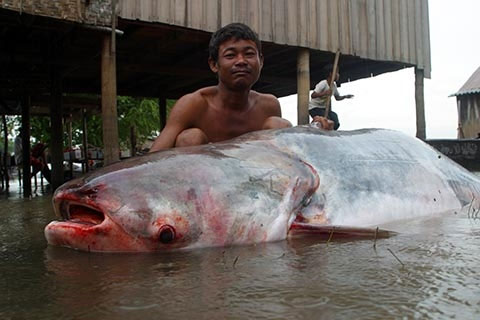The dam will make the Mekong catfish extinct
The dam construction on the main stream in the lower Mekong region may become a threat to the survival of the catfish species, one of the largest and rarest freshwater fish species in the world. , the latest study of the International Foundation for Nature Protection (WWF) said.
With a huge size, a length of up to 3 meters and a weight of about 300kg, this fish will not be able to cross the Xayaburi Dam during their annual migration journey, and this is likely to cause species extinction, the report said.
'A fish of this size will not be able to swim through a major obstacle like a dam to the upstream where their eggs are laid, ' said study author Professor Zeb Hogan at the University of Nevada. said.

Tra fish on the Mekong River.(Photo: Zeb Hogan / WWF)
'This giant creature needs a large flow and is open to being able to migrate. They also need quality water with certain flow conditions to carry out their life cycle including breeding and feeding , 'he said.
The study also found that populations of Mekong catfish have been significantly reduced due to overfishing, habitat destruction and the occurrence of dams on the Mekong tributaries.
A dam on the Mun River, the largest branch of the Mekong, has blocked the tra fish migration pathway and isolated the Mun River with the rest of the Mekong basin. The controversial dam - Xayaburi can interrupt, even prevent the breeding process, and increase the mortality rate of this fish if they swim through the dam's turbines, WWF reports. declare.
'It is possible that Mekong catfish use river tributaries, where Xayaburi dam is built, as their migration corridor. Adult individuals migrate from flood-prone growing areas, through the Xayaburi dam site, to upstream spawning areas , " adds Dr. Hogan. the area will build the dam '.
Pöyry, a Finnish company responsible for advising Laos on dam construction, argued that it would be possible to build 'fish migration routes' to help them cross turbines and swim upstream. However, this solution has never been tested in practice.
'In order to build this type of migration route, it is necessary to study fish species, their swimming ability and flow to attract them towards migration routes,' said Dr. Eric Baran from the International Fish Center. research is needed to ensure practical solutions. '
Mekong catfish has been widely distributed along the Mekong basin, from Myanmar to southwestern China. Until the early 1990s, this population was still relatively abundant. Since then, the number of these species has been significantly reduced and found only in the Mekong River and its tributaries in Laos, Cambodia and Thailand.
'The Mekong River catfish represents the ecological integrity of the Mekong River because it is very vulnerable to fishing pressure and river changes. Their status is the health index of the entire river, and the maintenance of species is an important part of sustainable management of the Mekong basin , 'said Dr. Lifeng Li, Program Director of Freshwater WWF demand said.
- Catch the rare giant catfish on the Mekong River
- Hydroelectric dams change the flow, the 'water monster' Mekong is on the verge of extinction
- Sent to giant gold catfish
- Giant catfish died deadly due to drought in Thailand
- Giant fish of the Mekong River
- 11 species of giant fish are in danger of extinction
- Giant monster fights are about to perish on the Me Kong line
- Dolphins on the Mekong River are about to become extinct
- The Mekong tiger may be extinct
- Dams threaten the Mekong's ecology
- Private farms successfully produce breeding catfish
- Admire the rare species of the Mekong
 Animal 'suffering' after hibernation
Animal 'suffering' after hibernation Why do goats climb well?
Why do goats climb well? Scientists were surprised to see chimpanzees eating turtles
Scientists were surprised to see chimpanzees eating turtles Giant catfish died deadly due to drought in Thailand
Giant catfish died deadly due to drought in Thailand